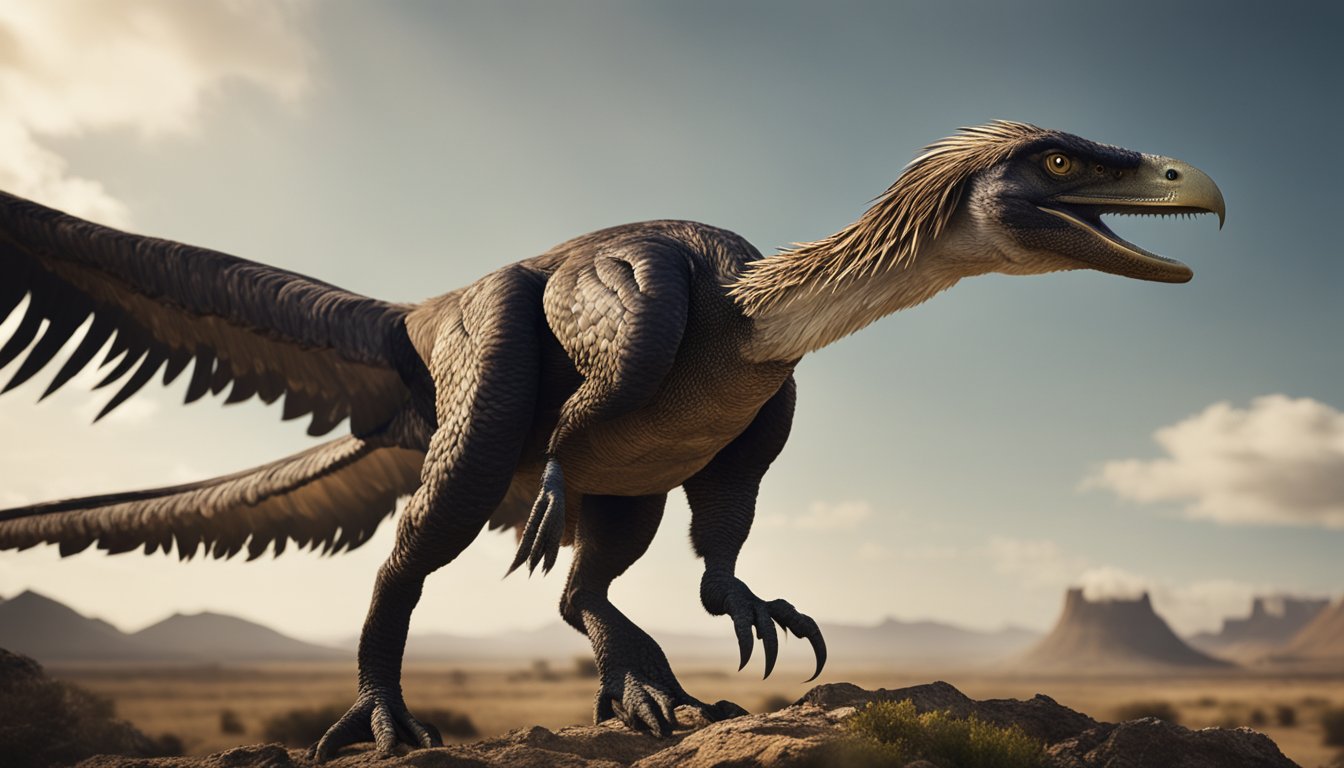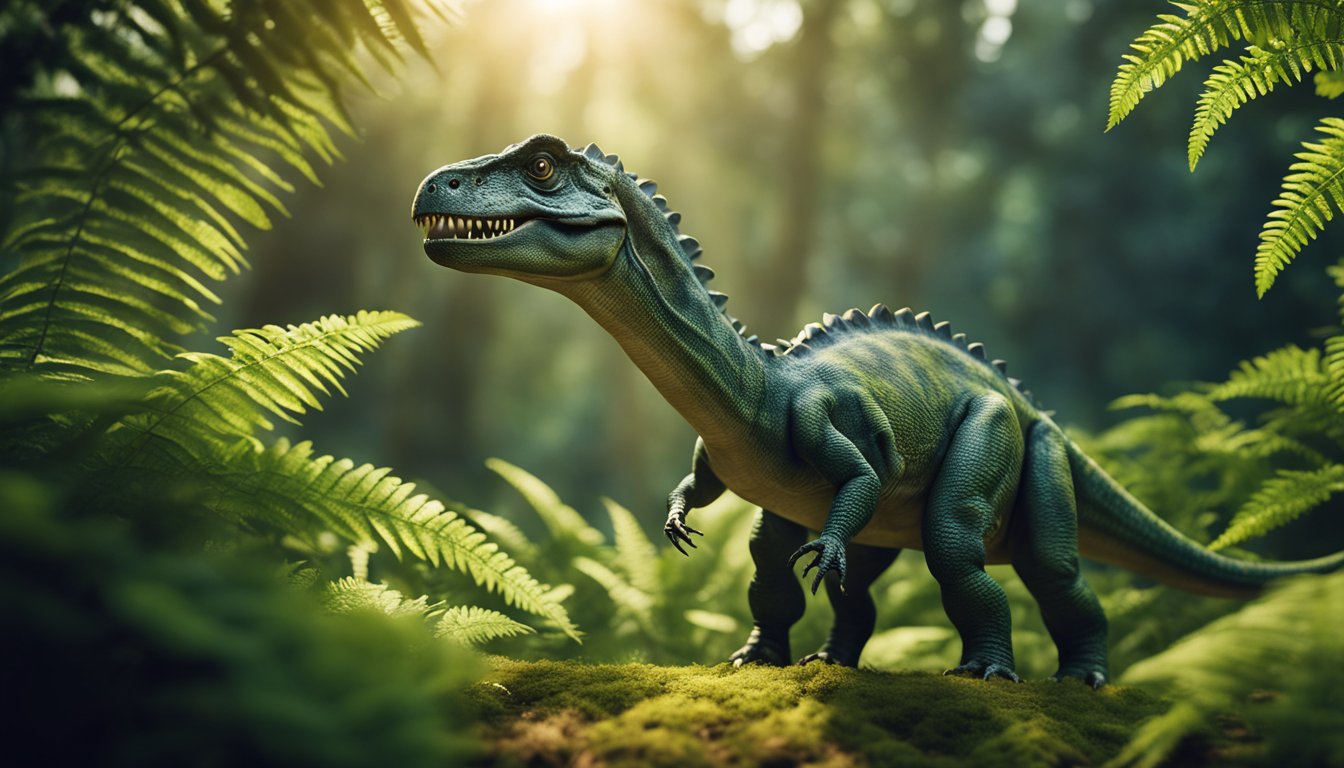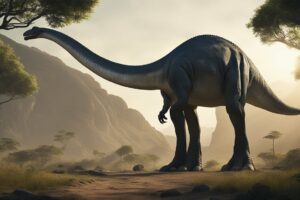Gigantoraptor is a dinosaur that has been shrouded in mystery since its discovery in 2005.
This giant bird-like dinosaur is believed to have lived in the late Cretaceous period, about 70 million years ago.
Scientists have been studying its fossils to learn more about its physical features and behavior.

One of the most fascinating things about Gigantoraptor is that it was a feathered dinosaur.
This discovery has challenged the traditional view of dinosaurs as scaly, reptilian creatures.
Gigantoraptor’s feathers were likely used for insulation and display rather than flight.
This suggests that feathers may have evolved in dinosaurs for reasons other than flight, which is a significant finding in the study of evolution.
Despite its massive size, Gigantoraptor was a fast runner and likely preyed on smaller animals. Its sharp claws and beak suggest that it was a carnivore.
However, there is still much to learn about this mysterious dinosaur.
Scientists continue to study its fossils and use advanced technology to reconstruct its appearance and behavior, shedding new light on the natural world and our understanding of prehistoric life.
Unearthing the Gigantoraptor

The Discovery in China
In 2005, a team of paleontologists led by Xu Xing uncovered an exciting fossil in the Erlian Basin of Inner Mongolia, China.
This fossil belonged to a new species of theropod dinosaur, which was named Gigantoraptor erlianensis.
The discovery was significant because it was the largest bird-like dinosaur ever found at the time, measuring over 8 meters in length and weighing around 2 tons.
The fossil was found in the Iren Dabasu Formation, which dates back to the Late Cretaceous period, about 85 million years ago.
The discovery site was located near the border between China and Mongolia, in an area that was once a floodplain with a diverse ecosystem of plants and animals.
Fossil Analysis and Identification
The holotype of Gigantoraptor erlianensis was found in a sandstone layer of the Bayan Shireh Formation.
The fossil consisted of a partial skeleton, including a skull, mandible, vertebrae, ribs, and limb bones.
The bones were well-preserved and showed several unique features that helped identify the species.
One of the most notable features of Gigantoraptor erlianensis was its large size and bird-like appearance.
The dinosaur had a long neck, a toothless beak, and long arms with sharp claws.
Its legs were also long and powerful, indicating that it was a fast runner.
The researchers suggested that Gigantoraptor erlianensis was an omnivore, feeding on plants, fruits, eggs, and possibly small animals.
The discovery of Gigantoraptor erlianensis provided new insights into the diversity of theropod dinosaurs and their evolution.
Scientists continue to study the fossil to learn more about this fascinating creature and its place in the prehistoric world.
Mysteries of Size and Appearance
Gigantoraptor is a dinosaur that continues to baffle paleontologists due to its unique bird-like features and massive size.
In this section, we will explore some of the mysteries surrounding its appearance and size.
Feathers and Beaks: Bird-Like Features
One of the most intriguing aspects of Gigantoraptor is its bird-like appearance.
It had feathers covering its body, which is a characteristic shared by many modern birds.
The feathers were likely used for insulation, display, and possibly even for flight.
The beak of Gigantoraptor was also bird-like, which suggests that it may have been an omnivore, eating both plants and animals.
Comparing Giants: Size and Weight Estimates
Gigantoraptor was a theropod dinosaur, which means that it was a meat-eater.
It was also a member of the Oviraptorosauria group of dinosaurs, which includes other feathered dinosaurs like Citipati and Oviraptor.
However, Gigantoraptor was much larger than these other dinosaurs.
Based on the holotype specimen, scientists estimate that Gigantoraptor was about 8 meters (26 feet) long and weighed around 1400 kilograms (3086 pounds).
This makes it one of the largest oviraptorids known to date.
To put its massive size into perspective, Gigantoraptor was about three times as long and 35 times more massive than Citipati, another oviraptorosaurid.
However, it was still much smaller than sauropod dinosaurs like Argentinosaurus, which could reach lengths of up to 40 meters (131 feet) and weigh up to 100,000 kilograms (220,462 pounds).
In conclusion, Gigantoraptor remains a mystery due to its unique combination of bird-like features and massive size.
Its feathered appearance and beak suggest that it may have been an omnivore, but its skeletal structure indicates that it was a theropod dinosaur.
Despite the mysteries surrounding Gigantoraptor, its discovery continues to fascinate scientists and dinosaur enthusiasts alike.
Fun Fact: Did you know that Gigantoraptor was discovered in 2005 by paleontologist Xu Xing in the Iren Dabasu Formation of Mongolia?
Lifestyle of a Cretaceous Enigma

Gigantoraptor was a giant bird-like dinosaur that lived during the Late Cretaceous period, approximately 85 million years ago.
This enigmatic creature has puzzled scientists for years due to its unusual features and scarcity of fossils.
Despite its size, little is known about the ecology, behavior, and social interaction of this dinosaur.
However, recent discoveries have shed some light on its lifestyle.
Diet and Feeding Habits
Gigantoraptor was an omnivore, feeding on plants, fruits, eggs, and possibly even crustaceans.
Its diet consisted of a variety of food sources, making it a versatile and adaptable dinosaur.
Its teeth were small and pointed, indicating that it was not a herbivore.
Instead, it had a powerful beak that it used to crack open eggs and crush small prey.
Behavior and Social Interaction
Gigantoraptor was a solitary dinosaur that lived in the plains of central Asia. It was a fast runner and could cover long distances in search of food.
Its large size made it an easy target for predators, so it had to be constantly on the lookout for danger.
Despite its imposing appearance, Gigantoraptor was a gentle giant that avoided confrontation whenever possible.
Gigantoraptor laid eggs like other oviraptorosaurs, but little is known about its reproductive behavior.
It is believed that it built nests on the ground and incubated its eggs using body heat.
The hatchlings were likely precocial, meaning that they were able to move around and feed themselves shortly after hatching.
In conclusion, Gigantoraptor was a fascinating dinosaur that remains shrouded in mystery.
Its dietary habits, behavior, and social interaction are still being studied by scientists around the world.
Despite its enormous size, it was a gentle herbivorous dinosaur that roamed the plains of central Asia during the Late Cretaceous period.
Gigantoraptor in Popular Culture

Gigantoraptor may have only been discovered in 2005, but it has already made its way into popular culture.
This giant bird-like dinosaur has been featured in various media, from video games to museums.
In the world of video games, Gigantoraptor has made appearances in several titles.
It is a playable character in the game “Jurassic World Evolution,” where players can create and manage their own dinosaur theme park.
Gigantoraptor is also a boss in the game “Dino Crisis 3,” where players must defeat it to progress through the game.
Museums around the world have also included Gigantoraptor in their exhibits.
The American Museum of Natural History in New York City, for example, has a life-size model of the dinosaur on display.
Visitors can see just how big this creature was and learn more about its unique characteristics.
Gigantoraptor has also been the subject of numerous documentaries and television shows.
These programs explore the dinosaur’s life and behavior, as well as the scientific discoveries that have been made about it.
They offer a fascinating glimpse into the world of paleontology and the ongoing quest to understand these ancient creatures.
Despite its relative newness to the scientific world, Gigantoraptor has already captured the imagination of people around the globe.
Its massive size, unique appearance, and mysterious origins make it a fascinating subject for study and exploration.
Whether you’re a dinosaur enthusiast or simply curious about the natural world, Gigantoraptor is sure to inspire wonder and awe.
Frequently Asked Questions

What size was the Gigantoraptor compared to other dinosaurs?
Gigantoraptor was one of the largest bird-like dinosaurs ever discovered, measuring up to 8 meters (26 feet) long and weighing around 1400 kilograms (3000 pounds) [1].
Compared to other known members of the Oviraptorosauria group, Gigantoraptor was much larger, about three times as long and 35 times more massive than the earlier discovered oviraptorosaurid Citipati.
How did Gigantoraptor use its beak if it didn’t have teeth?
Gigantoraptor, like other members of the oviraptorosaur family, had a sharp beak, but no teeth.
Despite this, it was still able to eat a variety of foods, including plants, small animals, and eggs.
Scientists believe that Gigantoraptor may have used its beak to break open eggs, which it may have eaten whole [2].
What evidence do we have that Gigantoraptor was a real dinosaur?
Gigantoraptor was first discovered in 2005 by Xu Xing in the Iren Dabasu Formation of Mongolia [1].
Since then, several well-preserved fossils of this dinosaur have been found, providing scientists with a wealth of information about its anatomy and behavior.
What did Gigantoraptor eat, and how do we know?
Scientists believe that Gigantoraptor was an omnivore, meaning that it ate both plants and animals.
Fossil evidence suggests that it may have eaten small animals, eggs, and plants.
In particular, scientists have found fossilized remains of gastroliths, which are stones that some animals swallow to help grind up food in their stomachs.
This suggests that Gigantoraptor may have eaten tough plant material, like leaves and stems [2].
How did Gigantoraptor’s feathers compare to those of modern birds?
Gigantoraptor, like other oviraptorosaurs, had feathers. However, these feathers were not like those of modern birds.
They were more primitive, with a simpler structure and less advanced features.
Despite this, Gigantoraptor’s feathers were still well-developed and may have helped it regulate its body temperature and attract mates [3].
What role did Gigantoraptor play in its ecosystem?
Gigantoraptor was a top predator in its ecosystem, feeding on a variety of small animals, eggs, and plants.
As an omnivore, it likely played an important role in maintaining the balance of its ecosystem by controlling the populations of its prey and helping to disperse the seeds of the plants it ate [2].






